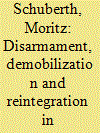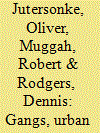|
|
|
Sort Order |
|
|
|
Items / Page
|
|
|
|
|
|
|
| Srl | Item |
| 1 |
ID:
153528


|
|
|
|
|
| Summary/Abstract |
Disarmament, demobilization and reintegration (DDR) programmes form part of standard post-conflict peacebuilding tools regularly applied in the context of UN peacekeeping operations. Yet, the limitations of such templates become evident when peacebuilders are confronted with unconventional settings, such as the urban environment. So far, there is a scarcity of research on UN-led DDR efforts in cities, even though the proliferation of urban armed groups is projected to pose an intractable challenge for decades to come. Based on six months of fieldwork in Port-au-Prince, this article presents new empirical evidence on innovative DDR programming in Haiti, the only country where a United Nations Stabilization Mission (MINUSTAH) tried to implement a traditional DDR programme for gang members. As this attempt proved to be a failure, the mission subsequently changed its approach to a more community-focused armed violence reduction and prevention programme which aims to disincentivize at-risk sections of the population from joining gangs. Even though the current community violence reduction approach is better adapted to the unconventional conflict environment in Haiti and is seen by many practitioners today as a role model, it shares a number of limitations with traditional DDR programmes and is not a panacea for urban peacebuilding.
|
|
|
|
|
|
|
|
|
|
|
|
|
|
|
|
| 2 |
ID:
092056


|
|
|
|
|
| Publication |
2009.
|
| Summary/Abstract |
Urban violence is a major preoccupation of policymakers, planners and development practitioners in cities around the world. Public authorities routinely seek to contain such violence through repression, as well as through its exportation to and containment at the periphery of metropolitan centres. Yet, urban violence is a highly heterogeneous phenomenon and not amenable to reified diagnosis and coercive intervention. Muscular state-led responses tend to overlook and conceal the underlying factors shaping the emergence of urban violence, as well as the motivations and means of so-called violence entrepreneurs. This is very obviously the case of urban gangs in Central America, which are regularly labelled a 'new urban insurgency' threatening the integrity of governments and public order. This article considers both the shape and character of Central American gang violence and attempts to reduce it, highlighting the complex relationship between these two phenomena. We advance a threefold approach to measuring the effectiveness of interventions, focusing in turn on discursive, practical and outcome-based criteria. In this way, the article demonstrates how, contrary to their reported success in diminishing gang violence, repressive first-generation approaches have tended instead to radicalize gangs, potentially pushing them towards more organized forms of criminality. Moreover, although credited with some modest successes, more preventive second-generation interventions seem to have yielded more rhetorical advances than meaningful reductions in gang violence.
|
|
|
|
|
|
|
|
|
|
|
|
|
|
|
|
|
|
|
|
|